
Nov . 21, 2024 16:24 Back to list
ammonium hydrogenphosphate
Ammonium Hydrogen Phosphate Properties, Uses, and Applications
Ammonium hydrogen phosphate, also known as monoammonium phosphate (MAP) or MAP fertilizer, is a highly soluble salt that plays a crucial role in agriculture and various industrial applications. Its chemical formula, NH4H2PO4, highlights its composition, consisting of ammonium (NH4^+) and dihydrogen phosphate (H2PO4^-) ions. This article explores the properties, uses, and applications of ammonium hydrogen phosphate, emphasizing its significance in agriculture and other sectors.
Properties
Ammonium hydrogen phosphate is a white crystalline solid with a slightly acidic taste. It is highly soluble in water, with its solubility increasing with temperature. This property makes it an attractive option for use in fertilizers, as it can be easily absorbed by plants. The compound has a molar mass of approximately 115.03 g/mol and a melting point of around 190 degrees Celsius, undergoing decomposition rather than melting. Additionally, MAP displays hygroscopic characteristics, meaning it can absorb moisture from the air, which can impact its storage and application.
Agricultural Uses
One of the most significant applications of ammonium hydrogen phosphate is in the fertilizer industry. MAP is primarily used as a source of phosphorus, which is an essential nutrient for plant growth. Phosphorus plays a vital role in several plant processes, including photosynthesis, energy transfer, and the synthesis of nucleic acids and proteins. Its availability can drastically influence crop yields, making MAP an essential fertilizer in modern agriculture.
MAP is particularly popular as a starter fertilizer. When applied during planting, it provides immediate access to phosphorus, facilitating root development and establishing stronger plants. This is particularly beneficial for crops that require substantial nutrient uptake early in their growth stages, such as corn, wheat, and various fruit and vegetable crops. In addition to phosphorus, MAP also supplies nitrogen, another crucial nutrient for plant growth, making it a well-rounded fertilizer choice.
ammonium hydrogenphosphate

Industrial Applications
Beyond agriculture, ammonium hydrogen phosphate has several industrial applications. It is widely used in the food industry as a food additive and an acidulant. Its unique properties allow it to act as a leavening agent in baking, helping to improve the texture and volume of baked goods. Additionally, MAP is used in the production of various food products, such as processed cheeses and meat products, where it serves both as an emulsifying agent and a protein stabilizer.
Furthermore, ammonium hydrogen phosphate is employed in the fire-fighting industry. It acts as a flame retardant and is commonly found in certain types of dry chemical fire extinguishers. By inhibiting combustion reactions, MAP can be effective in controlling fires in various environments.
Environmental Considerations
While ammonium hydrogen phosphate has numerous benefits, it is essential to consider its environmental impact. The overuse of MAP in agriculture can lead to nutrient runoff, which may contribute to water pollution and eutrophication in aquatic ecosystems. As such, there is a growing emphasis on the sustainable use of fertilizers, including MAP, to mitigate these environmental concerns. Practices such as precision agriculture, soil testing, and the integration of organic fertilizers can help minimize the adverse effects associated with excessive chemical fertilizer use.
Conclusion
Ammonium hydrogen phosphate is a versatile compound with wide-ranging applications, particularly in agriculture and various industrial sectors. Its properties, including high solubility and nutrient content, make it an invaluable resource for enhancing crop yield and food production. However, as with any chemical substance, responsible usage is crucial to sustaining both agricultural productivity and environmental health. Ongoing research and advancements in agricultural practices will continue to shape the future of ammonium hydrogen phosphate, ensuring its beneficial role in modern society while minimizing its environmental footprint.
-
Premium 8 12 16 Fertilizer – High-Efficiency Compound & Granular NPK Supplier
NewsJun.10,2025
-
High Quality Agricultural Grade NPK Fertilizer Manufacturer & Supplier Reliable Factory Price
NewsJun.10,2025
-
Organic Fertilizer for Corn Boost Yield Sustainably
NewsJun.10,2025
-
Organic Fertilizer for New Plants Natural Growth Boost & Eco Nutrients
NewsJun.10,2025
-
Optimized Hydroponic NPK Fertilizer – Fast Growth & Nutrients
NewsJun.09,2025
-
Top-Rated NPK Fertilizer for Fruit Trees - Boost Growth & Yield
NewsJun.09,2025
